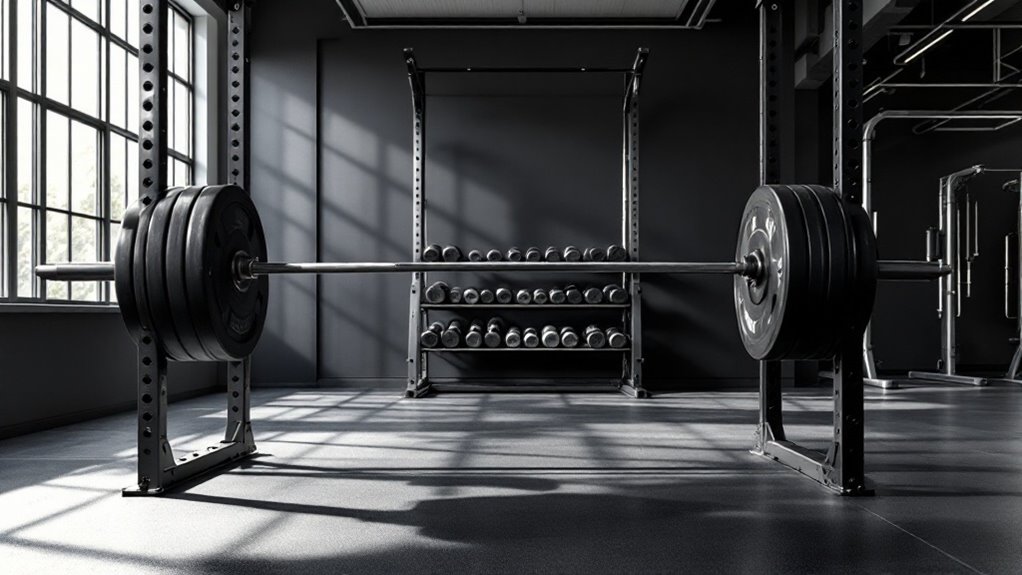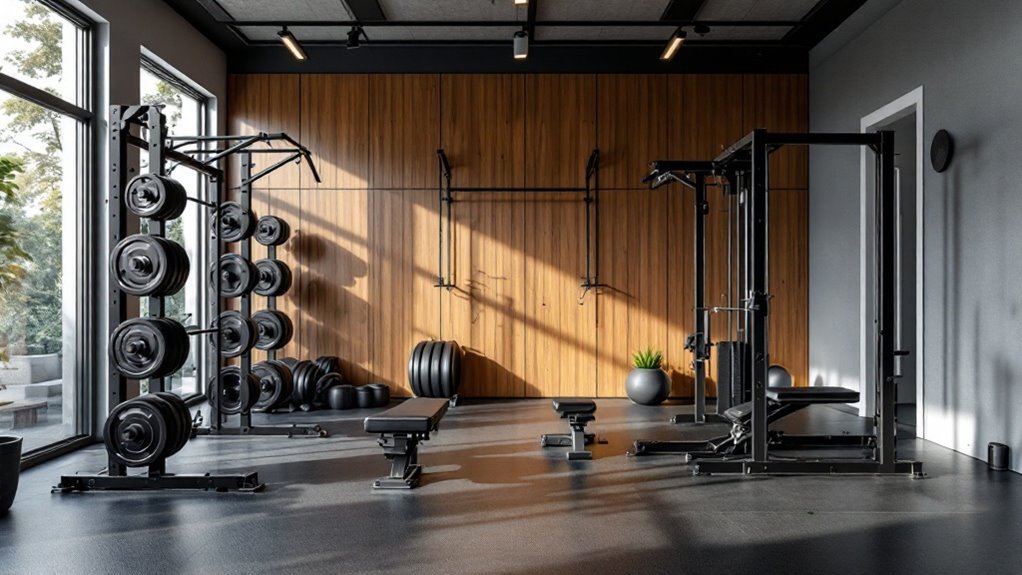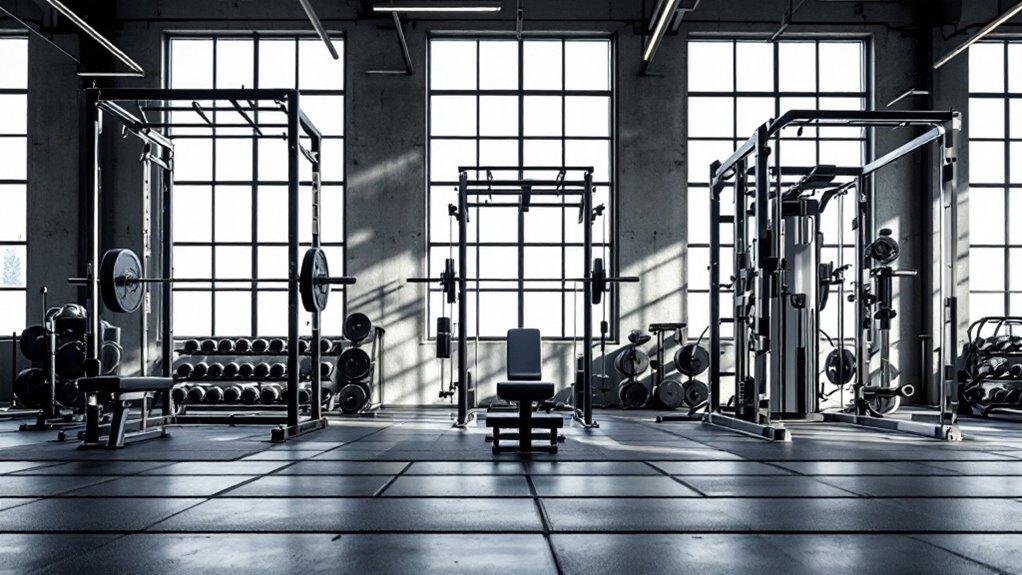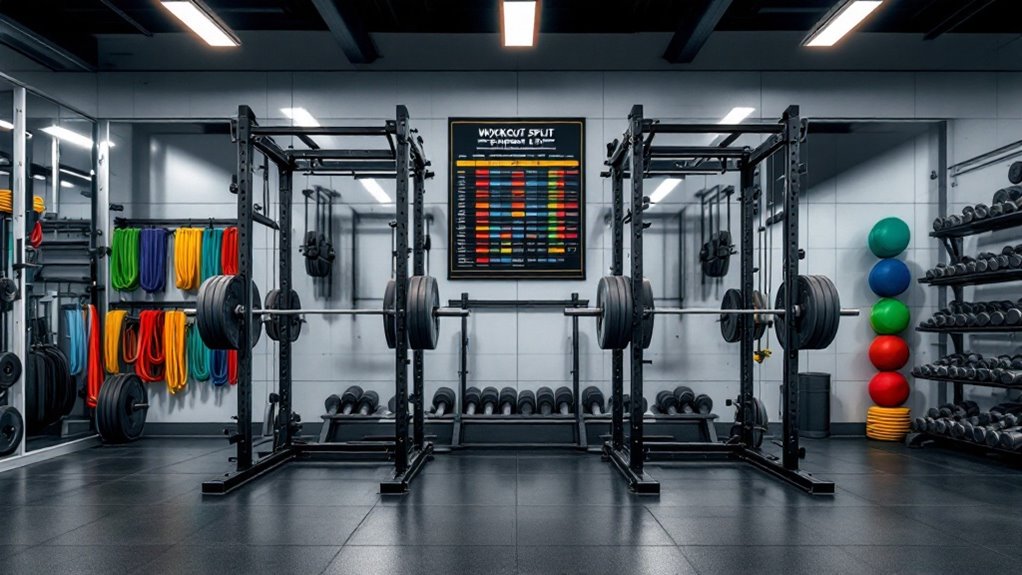Best Workout Splits for Muscle Gain

Training splits are essential for maximizing muscle growth by strategically spacing workouts throughout the week. The most effective splits include Push-Pull-Legs (PPL), Upper-Lower, and Body Part routines, with selection based on experience level and schedule. Beginners benefit from full-body workouts 3-4 times weekly, while intermediate lifters can progress to more frequent training days. Proper form, adequate rest between sessions, and progressive overload create the foundation for sustained muscle development. Understanding the science behind these splits reveals greater gains potential.
Key Takeaways
- Push-Pull-Legs splits effectively target muscle groups with optimal recovery time and can be performed 3-6 times per week.
- Upper-Lower splits provide balanced muscle development while allowing 48-72 hours between workouts for proper recovery.
- Full-body workouts 3-4 times weekly are ideal for beginners to build foundational strength and muscle mass.
- Body-part splits maximize muscle growth through specialized volume and are best suited for advanced lifters.
- All effective splits must incorporate progressive overload, adequate rest periods, and compound movements for optimal muscle gains.
The Science Behind Training Splits and Muscle Growth

Understanding the science behind training splits forms the foundation of effective muscle-building programming. When muscles undergo stress during resistance training, microscopic damage occurs in muscle fibers, triggering protein synthesis and adaptation.
This process, known as muscular hypertrophy, requires adequate recovery time between training sessions. Training splits optimize this recovery-growth cycle by systematically targeting different muscle groups on specific days.
This approach allows some muscles to rest while others work, maximizing overall gains. Research shows that proper split routines can increase training volume without overtaxing the central nervous system, leading to improved strength and muscle development when combined with proper nutrition and rest. Most programs incorporate compound movements as foundational exercises to stimulate the greatest muscle growth response.
Popular Workout Splits for Maximum Hypertrophy

A well-designed training split serves as the blueprint for maximum muscle hypertrophy, with several proven approaches standing the test of time in bodybuilding and strength training communities.
Among the most effective splits are the Push-Pull-Legs (PPL), Upper-Lower, and Body Part splits. PPL divides workouts into pushing movements, pulling movements, and leg exercises, allowing optimal recovery between sessions.
Upper-Lower alternates between upper and lower body training days, perfect for those training 4-5 times weekly. Body Part splits target individual muscle groups each session, ideal for advanced lifters seeking specialized volume and intensity.
The key is selecting a split that corresponds with recovery capacity and schedule constraints. Regardless of the chosen split, maintaining proper exercise form is essential for preventing injuries and ensuring consistent progress in muscle development.
Choosing the Right Split Based on Your Experience Level

Before selecting a workout split, experience level serves as the primary factor in determining which training structure will deliver ideal results.
Beginners should start with full-body workouts 3-4 times per week, allowing adequate recovery while building foundational strength and movement patterns.
Intermediate lifters can progress to upper/lower splits or push/pull/legs routines, training 4-5 days weekly. This increased frequency supports progressive overload while maintaining recovery.
Advanced trainees may benefit from specialized splits like body part splits or modified PPL routines, training 5-6 days per week. Their improved work capacity and recovery ability enable higher training volumes while managing fatigue effectively.
Regardless of experience level, proper protein intake timing remains crucial for maximizing muscle growth potential from any training split.
Optimizing Recovery and Progressive Overload in Your Split

Successful muscle growth requires mastering two fundamental training principles: progressive overload and strategic recovery. Trainers must systematically increase workout intensity while allowing adequate rest between sessions targeting the same muscle groups.
Building muscle demands both consistent intensity increases and smart recovery periods – two non-negotiable elements for sustainable strength gains.
For ideal recovery, lifters should space workouts targeting the same muscles 48-72 hours apart. They should also adjust sleep habits to get 7-9 hours nightly and maintain proper nutrition.
Progressive overload can be achieved by incrementally increasing weights, sets, or reps each session.
Tracking progress through detailed workout logs helps guarantee consistent progression while preventing overtraining. This methodical approach enhances muscle growth potential while minimizing injury risk.
For beginners especially, using seated bench press machines can provide extra stability while learning proper form and implementing progressive overload safely.
Frequently Asked Questions
Can I Build Muscle if I Only Train Three Days per Week?
Training three days per week is absolutely sufficient for building muscle.
The key lies in workout intensity and proper recovery time between sessions. A well-structured full-body routine focusing on compound exercises like squats, deadlifts, and bench press optimizes muscle growth potential.
Many successful bodybuilders started with 3-day splits. The body adapts and grows during rest periods, making this frequency ideal for both beginners and intermediate lifters.
Should I Change My Workout Split During Cutting Phases?
While cutting, maintaining the same workout split provides consistency and helps preserve muscle mass.
The primary changes should focus on nutrition and cardio rather than restructuring training. The only adjustments needed are potentially reducing training volume if recovery becomes impaired, and slightly increasing rep ranges to maintain muscle stimulation during the caloric deficit.
Intensity should remain high to signal muscle retention.
How Long Should I Stick to One Workout Split Before Switching?
Like a ship traversing through changing seas, a workout split requires time to demonstrate its true effectiveness.
Athletes should maintain a split for 8-12 weeks minimum, allowing proper adaptation and measurable progress. This timeframe enables the body to build neuromuscular connections and strength patterns.
However, if progress stalls for more than 2-3 weeks despite proper nutrition and recovery, consider making strategic adjustments to the program.
Is It Okay to Do Cardio on Rest Days?
Light cardio on rest days can benefit recovery by promoting blood flow and reducing muscle soreness.
However, keep it moderate – think walking, swimming, or light cycling.
Avoid intense cardio that could interfere with muscle recovery and growth. The key is finding balance: 20-30 minutes of low-intensity activity can improve recovery while maintaining the primary focus on strength gains and proper rest.
Can I Follow the Same Workout Split Year-Round?
While following the same workout split year-round is possible, it's not ideal for long-term progress. The body adapts to routine, leading to plateaus in muscle growth and strength gains.
Periodic changes in training splits every 8-12 weeks help prevent adaptation, maintain motivation, and stimulate new progress. These changes can be as simple as adjusting exercise order, rep ranges, or completely restructuring the split.
Final Thoughts
Training splits remain a cornerstone of effective muscle-building programs, backed by research showing the importance of adequate volume and recovery. While popular splits like push/pull/legs and upper/lower have proven successful, the best choice depends on individual factors like experience level and recovery capacity. The key lies in progressive overload and consistent execution rather than endlessly debating split structures. Smart programming combined with dedication eventually drives hypertrophy results.


